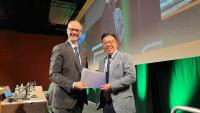Scoliosis
Make an Appointment
Our team of dedicated access representatives is here to help you make an appointment with the specialists that you need.
Scoliosis = a side-to-side curve in the spine. From the Greek word “skoliosis,” meaning “bending” or “crooked”
Director of our Spine Division, Dean Chou, MD explains adult scoliosis types and treatments:
Scoliosis is an abnormal curvature of the spine.
When viewed from behind, the typical spine is straight. A side-to-side curve in the spine that measures 10 degrees or more on an X-ray is called scoliosis. Scoliosis has to do with the structure of the spine; it is not the same as poor posture.
Symptoms
Scoliosis has many possible causes, and its symptoms can vary by cause.
Congenital scoliosis, which is due to a defect present at birth, can rarely produce weakness, numbness, or clumsiness if it affects the spinal cord.
Idiopathic scoliosis, which develops for no known cause, does not usually cause pain or other troublesome symptoms but can cause noticeable postural changes.
Diagnosis
It is common for children to be examined for scoliosis at school screenings. Many cases of scoliosis are detected during these screenings.
To confirm a diagnosis of scoliosis, the doctor may order the following diagnostic procedures to help see the entire spine from the base of the skull to the pelvis:
- X-Ray: provides detailed pictures of bones of the spine. Upright and dynamic (or flexion/extension) X-rays, which show the spine in motion, are the best way to assess the alignment and stability of the spine.
- Magnetic resonance (MR) imaging: a diagnostic procedure that uses a combination of large magnets, radiofrequencies, and a computer to produce detailed images of organs and structures within the body.
- Computed tomography (CT) scan: a diagnostic imaging procedure that uses a combination of X-rays and computer technology to produce detailed images of the body. A CT scan shows detailed images of any part of the body, including the bones, muscles, fat, and organs. CT scans are more detailed than general X-rays.
Risk Factors
Scoliosis is usually described in two ways: by the age at which a person is first affected, and the underlying cause of the curvature. Both factors—age and cause—influence treatment decisions.
Age
- Infantile: Birth to age 3. Infantile scoliosis usually develops within the first six months of life. The curves do not usually cause an infant any pain. Doctors will monitor children with infantile scoliosis and track the changes in their curves. Most infantile scoliosis resolves on its own, especially when the curves are mild. However, in some cases, curves can grow larger, and even become disabling, if they are not treated. Treatment may involve casting, bracing, and/or surgery. Treatment is generally successful.
- Juvenile: Ages 4-10. Juvenile scoliosis is different from infantile and adolescent scoliosis, because it arises at a time when the spine is not growing rapidly. It is more likely than the other two types to worsen over time, and very unlikely to resolve on its own. Treatment is often required. As with infantile scoliosis, treatment may involve casting, bracing, and/or surgery, and treatment is generally successful.
- Adolescent: Ages 11-18. Adolescent scoliosis is the most common type of scoliosis, and it has the best outlook. That is, the spinal curves in this group are least likely to progress and become troublesome. Each case must be evaluated independently, though: larger curves are more likely to progress, and adolescents with a lot of growing left to do are more likely to have their curves progress as they grow. Most adolescents do not experience pain from their curves. The exceptions are curves that progress quickly—these may cause pain. Treatment may involve bracing to try to halt the progression of moderate curves or surgery to correct severe curves.
- Adult: Older than 18. In adults, scoliosis may be the result of an untreated evolution of one of the types above (adult idiopathic scoliosis) or the result of a degenerative condition.
Cause:
Treatments
Adolescent idiopathic scoliosis:
Nonoperative treatment, including physical therapy, and strengthening and stretching exercises, may be an option for some patients.
If the curvature measures 25 to 40 degrees on an X-ray, the doctor may recommend a brace be worn for a specific period of time. Bracing is generally implemented in hopes of stopping the progression of the curve and preventing deformity. The type of brace and the amount of time spent in the brace will depend on the severity of the condition.




